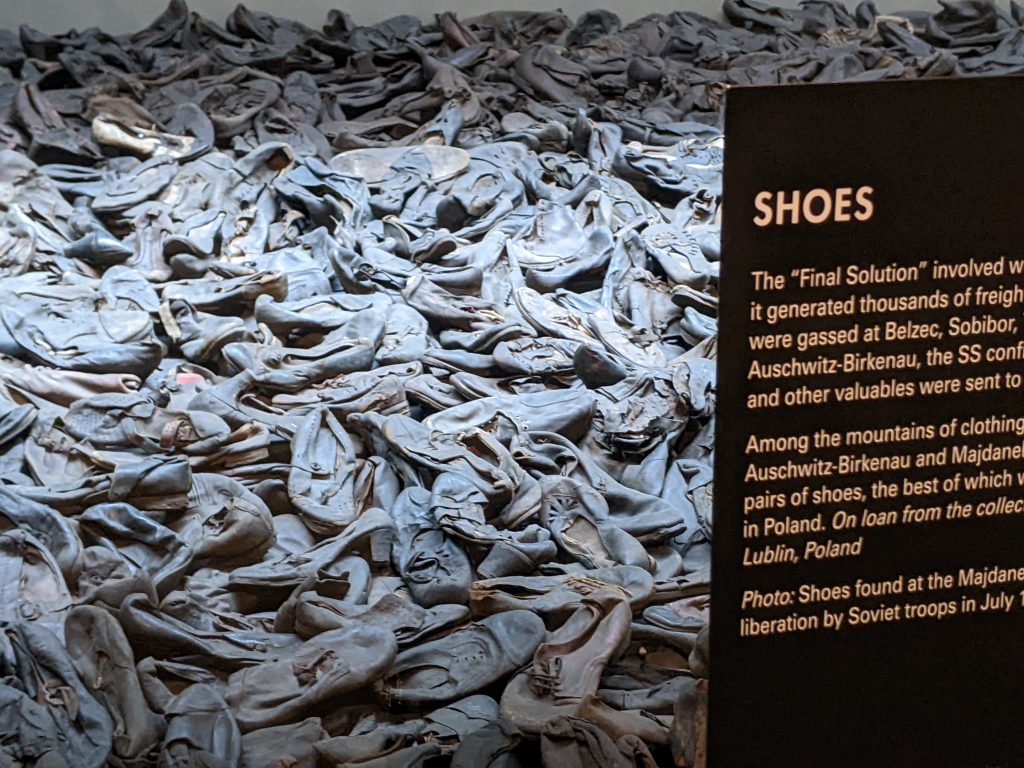How many Concentration Camps did the Nazi Regime have?

We are the shoes, we are the last witness.
We are the shoes from grandchildren and grandfathers
From Prague, Paris and Amsterdam.
And because we are only made of fabric and leather-
And not of blood and flesh- each one of us
Avoided the hellfire.
Moses Schulstein (1911-1981),
Yiddish Poet
Whilst Auschwitz is widely known as a concentration camp, the Nazi war machine had hundreds of camps all over eastern Europe until the war ended in 1945. In most instances, concentration camps full of prisoners in shocking conditions were discovered by allied troops.
Determining the true impact and death tolls from Nazi Concentration camps is close to impossible; there is no single wartime document that provides conclusive detail. However, we know that over 10 million people lost their lives in Nazi Concentration camps between 1941 and 1945.
Dachau, the first Nazi Concentration camp, was set up for those deemed enemies of the state – Roma and Sinti (Gypsy) people, Poles, homosexuals, Jehovah’s Witnesses, Freemasons, political dissidents and people with intellectual and physical disabilities. Later as Nazi Germany annexed Austria in March 1938, thousands of Austrian and German Jews were arrested and sent to concentration camps throughout Europe.
Here we have outlined the main concentration camps built by Nazi Germany throughout World War 2 to create awareness of the depth of the :
Auschwitz camp
Located in German-occupied Poland, the Auschwitz camp was one of the largest of its kind consisting of three camps, including a killing centre. This camp had concentration, labour, and extermination camps. According to the United States Holocaust Memorial Museum, 1.1 million, including 1 million Jews, were killed at the Auschwitz camp.
Bergen Belsen Camp
Bergen Belsen became a part of the Nazi Concentration Camps in 1943, and it is estimated that around 50,000 people died there due to horrific living conditions. Due to a lack of sanitation, the camp was overcrowded, and disease and starvation were the norm. The tyranny of this camp ended after the British troops liberated them on April 15, 1945.
Buchenwald Camp
Buchenwald Camp was one of the most significant concentration camps established within German borders. The Nazi regime established Buchenwald Camp in 1937. As the US forces liberated the camp on April 11, 1945, they found more than 21,000 inmates captive within Buchenwald Camp. Exact mortality figures for the Buchenwald site can only be estimated as camp authorities never registered a significant number of prisoners. The SS murdered at least 56,000 male prisoners in the Buchenwald camp system. Some 11,000 of them were Jews.
Dachau Camp
Head of the SS, Heinrich Himmler, describes Dachau Camp as “the first concentration camp for political prisoners.” Located around 10 miles northwest of Munich, the Dachau camp started in March 1933 and continued till the American forces liberated the camp in April 1945. The camp incarcerated more than 200,000 prisoners within two years. The exact number of victims who died in Dachau will never be known. However estimates put the figure well over 28,000
Flossenbürg Camp
Flossenbürg concentration camp was established in north-eastern Bavaria due to its potential for granite extraction. Roughly 97,000 prisoners went through the Flossenbürg system, and 30,000 died between 1938 and 1945.
Gross-Rosen Camp
Gross-Rosen camp became independent from Sachsenhausen concentration camp in 1941 and was located beside the same-named village in present-day Poland. Till January 1945, the Gross-Rosen complex captivated 76,728 prisoners with 26,000 women. This was one of the few camps with a large number of female prisoners.
Herzogenbusch camp
Herzogenbusch concentration camp was built in Vught, Netherlands and started functioning on January 13, 1943. This camp was established to balance out the existing malfunctioning camp at Amersfoort. Herzogenbusch’s camp imprisoned an estimated 30,000 people across the six different camp sections.
Kaiserwald camp
After the German Army had occupied Latvia, they built the Kaiserwald concentration camp to capture hundreds of convicts from Germany and the Jews of Latvia. Between March 1943 to October 1945, the camp had 11,878 inmates.
Kauen concentration camp
Kauen camp was set up in the former Kovno Ghetto, where Jews worked as forced labour. The daily life Jewish population in Kovno was disrupted when the Soviet Union occupied Lithuania, but after the German invasion, the Nazis governed every aspect of their life. In July 1944, they evacuated the camp by deporting most of the Jews to the Dachau concentration camp.
Majdanek concentration camp
The Majdanek system was both a concentration camp and an extermination camp. This base started in October 1941 with the arrival of Soviet prisoners. The SS gradually relocated Jews from Germany, Austria and modern-day Czech Republic and Slovakia to the camp for forced labour. It is estimated that approximately 78,000 inmates were exterminated in the Majdanek concentration camp.
Mauthausen Camp
For a few months after the annexation of Austria in 1938, Nazi Germany set up the Mauthausen Concentration Camp in the market town of Mauthausen, Upper Austria. The united states holocaust memorial museum estimates that between August 1938 to May 1945, around 197,464 prisoners passed through the camp. At least 95,000 victims died.
Dora-Mittelbau Camp
Dora-Mittelbau was initially a subcamp of Buchenwald, located near Nordhausen in Central Germany, but the SS made this camp an independent concentration camp with 30+ subcamps in October 1944. US Army released the slavery camp with approximately 60,000 inmates in April 1945.
Natzweiler-Struthof camp
Natzweiler-Struthof camp was established near the town of Natzweiler (modern-day Bas-Rhin, France) in 1941. In April 1945, as the Allied forces approached to liberate the camp, the Germans forcefully evacuated prisoners to the Dachau camp. Within the four years of the camp’s existence, around 20,000 people died.
Neuengamme camp
Neuengamme was initially a subcamp of Sachsenhausen, but gradually with more than 80 subcamps, it became one of the largest concentration camps in Northwest Germany. By the time the British troops approached Neuengamme in April 1945, around 50,000 inmates had ceased to exist.
Ravensbrück camp
Ravensbrück, the largest concentration camp for women, was located about 50 miles north of Berlin. With over 40 subcamps, Ravensbrück had over 70,000 female prisoners from over 30 countries.
Sachsenhausen camp
Sachsenhausen was the main concentration camp established by the SS in July 1936. By 1945, the camp had imprisoned more than 200,000 people, with an approximate death toll of 100,000.
Stutthof camp
The Stutthof concentration camp was established near the village of Stutthof, 22 miles east of Danzig. It started as a labour education camp in 1941 and became a regular concentration camp by January 1942. It is estimated that as many as 100,000 people were deported to this camp and more than half died there.
Warsaw Camp
In 1943 the SS seized more than 8000-9000 Jews from the Jewish Warsaw Ghetto, Poland and forced them into the Labour Camp. The SS and police force wanted to remove the ghetto, so all the un-deported inhabitants were sent to forced labour camps in the Lublin district. Around 7000 Jews had given up their lives while fighting or hiding in the ghetto.
Jasenovac Camp
Jasenovac was a camp situated in the village of the same name in Croatia. Here it operated as an extermination camp for Serbs, Jews and other ethnic groups – it quickly became one of the largest concentration camps in Europe. Death toll estimates are near 100,000 people in Jasenovac between 1941 and 1945.
Throughout World War 2, there were more than 1000 concentration camps in Eastern Europe, including sub-camps. The sheer volume of people ‘processed’ through the camps forced the Nazi SS to adopt almost assembly-line-like methods to exterminate tens of millions of people.
Thousands of pages of documents recovered by allied forces show, in shocking detail, the true aims of the Nazi war machine and how they planned to change the world in the name of fascism.
Sources
https://www.jewishvirtuallibrary.org/list-of-major-nazi-concentration-camps
Header Image – The Shoes from Concentration Camp: United States Holocaust Museum D.C
